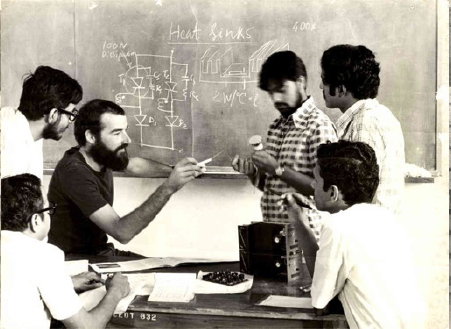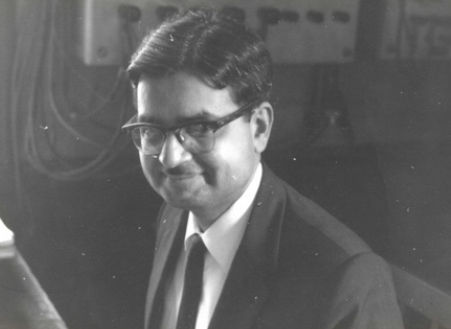The journey of Foundation of CEDT started with the Bhabha Committee which the Government of India had formed with Dr Homi Bhabha and a group of very distinguished scientists and technologists to recommend what should be done in the country in the next five years in order to make better use of electronics. As Electronics was becoming all-important, especially for national security, but we had done very little. It was pointed out that if we don’t take immediate measures we would be left in the lurch and others would score over us. Also, the electronics industry had to grow to bring in employment opportunities for our people, and we had to become self-sufficient.


In 1970, the GOI organised a National Conference on Electronics at the Tata Institute of Fundamental Research, Bombay. The conference had a session on education, in which industry people told IISc Delegates that the knowledge imparted to students in classrooms was not suitable for their requirements, they wanted the students to develop something new. A visiting professor from the US, Prof Thomas Kailath suggested about Dr Arvind Shah who has also been talking of this, and planning similar things. As Similar problems were also arising in Switzerland because technology keeps changing so rapidly.
Prof BN Narayana Iyengar Chairman of the Electrical Sciences Division & Nithyanand Rao brought together people from industry for a discussion meeting where people agreed that we can work out a one-year or a one-and-a-half year program, which will superpose on the BE degree.
Dr Shah contacted the Swiss Agency for Development and Cooperation [SDC], who could support the programme. And finally, the Governments of India and Switzerland signed an agreement in August 1974 to establish CEDT at the Institute. It was Prof BS Sonde who had done all the spadework on the Indian side and had made sure that IISc could administratively integrate the CEDT. Both of us had met with government officials in India and Switzerland.
The Electronics Commission of the Government of India played an essential role in financing the CEDT on the Indian side. The CEDT had been allotted some space within the building of the ECE department. But this space, in May 1975, consisted only of a few empty rooms; the furniture for our future laboratories and offices was still in the process of being fabricated. There was no equipment at all; some of it was still to be bought in India, another part of it, which had been ordered outside India, based on funds from the Swiss government, was held up by customs in Chennai. There was no staff as yet, except for a secretary; two faculty members, Dr H S Jamadagni and Dr Bhat, who were still in Switzerland for their “training period”; the technical staff was yet to be engaged.


BS Sonde, retired professor of electrical communication engineering, was the founding chair of the Centre for Electronics Design and Technology (CEDT). First batch of 10 students arrived for their one-year Diploma programme in August 1975, we were indeed ready to receive them and to put them to work in our labs, which were just coming into shape. The 10 first students were all very dedicated and hardworking. We had set as a precondition that they should have a few years of professional experience and that their present employers should send them to the CEDT on deputation.
The CEDT course was several years later modified to become a Masters programme and to accept young engineers directly from university, without professional experience and without industrial sponsorship. From then on, there was no difficulty anymore in finding enough students and the CEDT students definitely had more intellectual brilliance.
The generous support provided by the DoE, especially during the Seventh Plan period, enabled the Centre to move into its own building, and explore many avenues and establish a good postgraduate degree programme to train engineers as designers of electronic equipment. Swiss funding enabled many of the faculty of CEDT to work in several industries and R and D laboratories of Switzerland, to benefit from several short and long-term Swiss experts, and to ensure smooth functioning of the Centre. CEDT established an excellent contact with the electronic industries after the structural changes that took place in the Indian Industry during the 90s.
In 1984, the programme was opened to non-sponsored students. The postgraduate Diploma Programme was replaced by an M. Tech. in Electronic Design and Technology in 1987. Research programmes leading to MSc (Engg) and Ph.D. were introduced in 1992. External registration for research programmes was introduced in 1995. ME in Microelectronics was introduced in 1997 as a joint programme between CEDT and Electrical Communication Engineering department.
The centre by then had become a complete department within the division of Electrical Sciences of the Indian Institute of Science. In January 2012, CEDT was renamed as Department of Electronic Systems Engineering (DESE). This new name that includes the key word “system” resonates very well with the approach that has been followed in the department down the years, viz., the approach of building prototypes that take into account a multitude of practical issues, including industrial design and product engineering, ergonomics, system-level packaging and thermal design. In essence this captures the core competence of the department, and reflects accurately the spirit of activities in the department.

It has been 50 years and the Department of Electronic Systems Engineering is every year creating history with achieving new milestones.